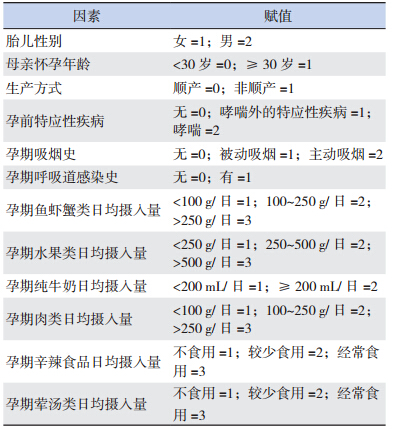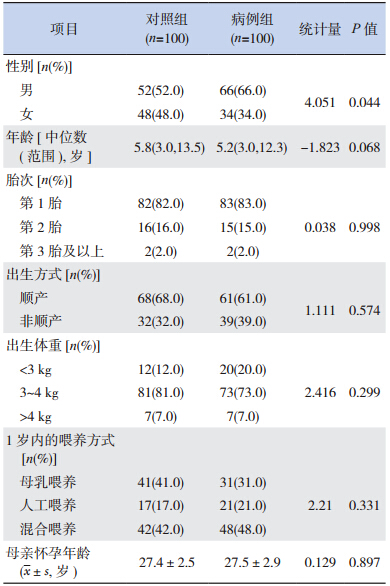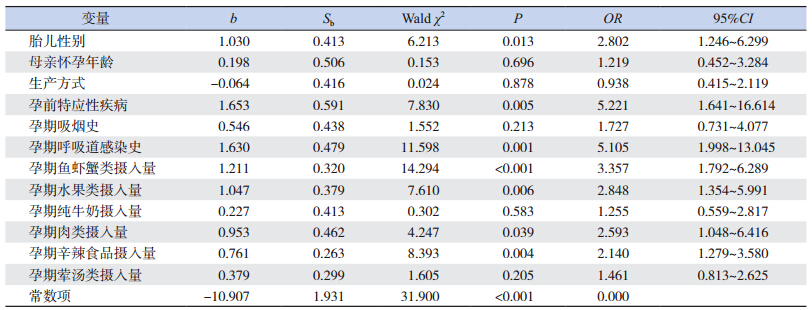支气管哮喘是儿童最常见的慢性呼吸道疾病, 严重影响患儿身心健康,也给家庭和社会带来沉 重的精神压力和经济负担 [1]。近十余年来儿童哮喘 的患病率有明显上升趋势,甚至在医疗条件优越 的发达国家中 [2]。哮喘儿童多在婴幼儿期即呈现一 种特应性体质,常表现一种或几种特应性疾病, 如湿疹、过敏性结膜炎、过敏性鼻炎、婴幼儿喘 息等,有研究表明这与母亲孕期环境暴露有密切 关系 [3, 4, 5, 6]。婴幼儿期反复喘息的儿童今后患哮喘的 几率很高 [7],而我们在长期的临床实践中发现,哮 喘儿童婴幼儿期的反复喘息与母亲孕期的饮食、 患病等环境暴露情况相关。如果能确定与哮喘儿 童婴幼儿期喘息相关的孕期危险因素,并尽早进 行有效积极的早期预防,对降低儿童哮喘的发病 将是十分有益的。因此本研究针对婴幼儿期即 3 岁前起病的哮喘儿童,对其母亲孕期饮食、疾病 及其他环境暴露等情况开展回顾性调查,力图通 过更为客观的流行病学研究方法分析母亲孕期因 素与婴幼儿期即开始喘息的儿童哮喘的相关性及 其危险度。现将研究结果报告如下。 1 资料与方法 1.1 研究对象
随机抽取 2012 年 7 月至 2013 年 12 月来我院 儿科就诊的 100 例 3 岁前起病的哮喘儿童为病例 组。病例组全部病例均符合中华医学会儿科学分 会呼吸学组 2008 年修订的“儿童支气管哮喘诊断 与防治指南”中有关儿童哮喘的诊断标准 [7]。并随 机选取 100 例同期来我院体检或就诊的无过敏性 疾患的儿童作为对照组。所有研究对象均来自江 苏地区,获得儿童及家长的知情同意。 1.2 研究方法
采用临床病例对照研究方法,参考国内外相 关文献研究结果制定统一的调查表,调查员为具 有相关专业知识并经过统一培训的儿科医师。调 查内容包括:儿童一般情况(出生年月、性别、 住址、联系方式等)、首次喘息年龄、个人及家 族过敏史资料(湿疹、过敏性鼻炎、药物过敏史, 哮喘病史等)、围生期资料(母亲怀孕及生产情 况)、出生第 1 年的喂养情况;母亲孕期患病及 环境暴露情况(包括孕期患病情况、有无吸烟史、有无饮酒史等)和孕期饮食日均摄入情况(即日 均摄入鱼虾蟹类、纯牛奶、水果类、肉类、荤汤类、 辛辣食物等的情况)。主要调查指标经初步分析 后进行指标筛选和赋值,见表 1。
| 表 1哮喘患儿母亲相关孕期影响因素与赋值方法 |
应用 SPSS 18.0 统计软件进行统计学处理,计 量资料用均数 ± 标准差(x±s)或中位数(范围) 表示,计数资料以例数 / 百分率表示。计数资料采 用卡方检验;符合正态分布的计量资料两组间比 较采用成组 t 检验,不符合正态分布者采用 MannWhitney U 秩和检验。应用单因素非条件 logistic 回 归分析对母亲怀孕期间的相关因素进行分析,筛 选出有统计学意义的变量,然后采用非条件多因 素 logistic 回归模型进行分析。 P<0.05 为差异有统 计学意义。 2 结果 2.1 病例组和对照组一般情况的比较
病例组 100 例患儿中,男 66 例,女 34 例; 对照组 100 例中,男 52 例,女 48 例,两组性别 分布比较差异有统计学意义(P<0.05)。病例组年 龄 3~12.3 岁,平均 5.7 岁;对照组年龄 3~13.5 岁,平均 6.4 岁,两组比较差异无统计学意义(P>0.05)。 两 组 儿 童 胎 次、 出 生 方 式、 出 生 体 重 分 级、生后第 1 年喂养方式比较差异无统计学意义 (P>0.05)。母亲怀孕年龄两组比较差异无统计学 意义(P>0.05)。两组一般情况比较见表 2。
| 表 2两组一般情况比较 |
通过对胎儿性别、母亲怀孕年龄、生产方式、 孕前特应性疾病史、孕期吸烟史、孕期呼吸道感 染史、孕期鱼虾蟹类摄入量、孕期水果类摄入量、 孕期纯牛奶摄入量、孕期肉类摄入量、孕期辛辣 食品摄入量、孕期荤汤类摄入量 12 个变量进行单 因素 logistic 回归分析,发现胎儿性别、孕前特应 性疾病史、孕期呼吸道感染史和孕期鱼虾蟹类、 水果类、肉类、辛辣食品摄入量 7 个因素与婴幼 儿期起病的儿童哮喘有显著相关性;而母亲怀孕 年龄、生产方式、孕期吸烟史、孕期纯牛奶摄入量、 荤汤类食物摄入量无统计学意义(表 3)。
| 表 3各相关因素的单因素 logistic 回归分析 |
为排除混杂因素影响,将单因素分析筛选出 7 个变量进一步行多因素 logistic 回归分析,结果显 示胎儿性别、孕前特应性疾病史、孕期呼吸道感 染史和孕期鱼虾蟹类、水果类、肉类、辛辣食品 摄入量 7 个因素最终均进入主效应模型,它们是婴幼儿期起病的儿童哮喘的独立危险因素(表 4)。
| 表 4各相关因素的多因素 logistic 回归分析 |
支气管哮喘是一种呼吸系统变应性疾病,是 由免疫、遗传、环境以及其他因素共同作用而引 起的多基因遗传病,其发病呈现多因性和异质性, 并由不同的遗传机制控制 [7]。
婴幼儿期是喘息性疾病的高发年龄期,儿童 哮喘有 80% 以上起始于婴幼儿期 [8]。近年来,国 外已有文献提出应注重环境控制和过敏性疾病的 预防,并强调应从胎儿和婴幼儿开始 [9]。自怀孕起, 孕妇的免疫系统和胎儿之间就建立了密切的相互 作用,通过胎盘交换免疫信息。Vance 等 [10] 发现, 16 周胎儿的羊水和足月(≥ 37 周)胎儿循环中有 妊娠母体的抗原,证实母体内的抗原可通过羊水 和胎盘到达胎儿,提示母孕期暴露的抗原可启动 胎儿免疫反应致婴儿期致敏。Prescott 等 [11] 研究也 证实出生时外周血单个核细胞均可发生对各种抗 原的抗原特异性增殖反应,提示胎儿免疫在宫内 已被启动。血清 IgE 升高是过敏性疾病最有力的提 示,多年来被视为过敏性疾病的主要诊断依据。 胎儿于 11 周开始具有合成 IgE 的能力,IgE 不能 通过胎盘屏障,因此脐血 IgE 水平不受母体水平的 影响,但母体的大分子抗原可以通过胎盘进入胎 儿循环,则可能刺激胎儿产生抗原特异性的 IgE, 即发生宫内致敏 [12]。有研究表明,脐血 IgE 水平 高者,其发生过敏性疾病的机会亦随之增加 [12, 13, 14], 因此,胎儿的宫内环境对婴幼儿时期过敏性疾病 的发生具有重要影响,对婴幼儿过敏性疾病如哮 喘的早期干预,应从孕母着手。
本研究通过非条件 logistic 多因素回归分析 最终确定了胎儿性别、孕前特应性疾病史、孕期 呼吸道感染史、孕期鱼虾蟹类、水果类、肉类、 辛辣食品的摄入量是婴幼儿期起病的儿童哮喘的危险因素。其中胎儿性别和孕前特应性疾病史这 两种危险因素已经被普遍证实,如父母双方所患 同一种变应性疾病,其子女患该类疾病的概率为 78.0%;如果仅一方有变应性疾病,其子女患病概 率为 35.0%[15]。而本研究发现的母亲孕期呼吸道感 染是婴幼儿期起病的儿童哮喘的危险因素,文献 报道较少,值得进一步深入研究。Hughes 等 [16] 研 究显示孕早期呼吸道感染与婴幼儿生后的反复喘 息之间有一定相关性,并认为其原因可能为呼吸 道病毒可通过胎盘建立一个 “异常”胎儿免疫, 也许可以部分解释孕期呼吸道感染成为哮喘危险 因素的原因。越来越多的证据显示,孕期母亲饮 食(如鱼、水果类、蔬菜等食物和维生素 D、维 生素 E、不饱和脂肪酸等营养素)与儿童哮喘及其 他变应性疾病相关 [4, 5, 17, 18, 19]。有研究认为母亲孕期摄 入鱼类对降低儿童过敏相关疾病的风险有益 [20]。 但近期荷兰的一项前瞻性队列研究显示,母亲孕 期饮食中贝类水生动物的消耗量与儿童喘息和湿 疹的高风险相关,而多脂鱼的消耗量与湿疹的高 风险有关,少脂鱼的消耗量与喘息和湿疹却无相 关性 [21]。 本研究也显示,孕母鱼虾蟹类摄入量 是哮喘儿童婴幼儿期起病的一项危险因素。孕母 摄入水果对子代患变应性疾病的影响目前颇有争 议 [22, 23],本研究提示水果过多摄入反而会增加子代 哮喘的患病风险。上述研究之所以会得到不一致 甚至相矛盾的研究结果,可能与摄入鱼虾蟹和水 果的种类及数量相关,但还需要更多的证据去验 证。有研究发现,高肉类的摄入与鼻炎的高发病 率相关,但对哮喘的患病影响则不确定 [24]。本研 究显示孕母高肉类摄入是儿童哮喘一项危险因素。 另外,本研究还发现孕期辛辣食品摄入量也是婴 幼儿喘息的危险因素,但对此尚未见文献报道。 目前这些因素对儿童哮喘产生影响的潜在机制尚不清楚,需进一步研究。
有研究认为,家庭中的被动吸烟会加重气道 的高反应性 [25],而本次调查未能证实孕期吸烟对 哮喘儿童 3 岁前起病有影响。可能与目前江苏地 区育龄青年对孕期保健、吸烟不宜于健康等意识 明显增强,在怀孕期间及小儿出生后,吸烟环境 明显改善,吸烟人数较少有关。另外本研究也未 发现母亲怀孕年龄和生产方式与哮喘儿童 3 岁前 起病具有相关性。
本研究发现的儿童哮喘的危险因素中胎儿性 别、孕前特应性疾病史是不可避免的,而母亲怀 孕期间的饮食情况和呼吸道感染却是可控因素, 这对指导儿童哮喘等过敏性疾病的早期预防是有 重要意义的。下一步我们还将开展大样本、多中 心、相关影响因素分类更加细化的流行病学研究, 以获得更为准确的数据指导临床实践。
| [1] | Masoli M, Fabian D, Holt S, et al. The global burden of asthma:executive summary of the GINA Dissemination Committee Report[J]. Allergy, 2004, 59(5):469-478. |
| [2] | Saadeh D, Salameh P, Baldi I, et al. Diet and allergic diseases among population aged 0 to 18 years:myth or reality?[J]. Nutrients, 2013, 5(9):3399-3423. |
| [3] | Yong SB, Wu CC, Wang L, et al. Influence and mechanisms of maternal and infant diets on the development of childhood asthma[J]. Pediatr Neonatol, 2013, 54(1):5-11. |
| [4] | Chen F, Marquez H, Kim YK, et al. Prenatal retinoid deficiency leads to airway hyperresponsiveness in adult mice[J]. J Clin Invest, 2014, 124(2):801-811. |
| [5] | Miyake Y, Tanaka K, Okubo H, et al. Maternal fat intake during pregnancy and wheeze and eczema in Japanese infants:the Kyushu Okinawa Maternal and Child Health Study[J]. Ann Epidemiol, 2013, 23(11):674-680. |
| [6] | Dotterud CK, Storro O, Simpson MR, et al. The impact of preand postnatal exposures on allergy related diseases in childhood:a controlled multicentre intervention study in primary health care [J]. BMC Public Health, 2013, 13:123. |
| [7] | 中华医学会儿科学分会呼吸学组, 《中华儿科杂志》编辑委 员会. 儿童支气管哮喘诊断与防治指南[J]. 中华儿科杂志, 2008, 46(10):745-753. |
| [8] | 陈强, 代佳佳. 儿童支气管哮喘诊断和治疗的热点问题[J]. 中国当代儿科杂志, 2013, 15(8):601-603. |
| [9] | Schonberger HJ, Dompeling E, Knottnerus JA, et al. Prenatal exposure to mite and pet allergens and total serum IgE at birth in high-risk children[J]. Pediatr Allergy Immunol, 2005, 16(1):27-31. |
| [10] | Vance GH, Holloway JA. Early life exposure to dietary and inhalant allergens[J]. Pediatr Allergy Immunol, 2002, 13 (Suppl 15):14-18. |
| [11] | Prescott SL, Taylor A, Roper J, et al. Maternal reactivity to fetal alloantigens is related to newborn immune responses and subsequent allergic disease[J]. Clin Exp Allergy, 2005, 35(4):417-425. |
| [12] | 宋飞, 周晓珊, 王陶, 等. 羊水胎粪污染新生儿脐血IgE 水平 测定及意义[J]. 中国当代儿科杂志, 2007, 9(4):361-363. |
| [13] | 黄志坚, 黄翠玲, 邹红梅, 等. 广州地区高危儿新生儿脐血 IgE 对预防婴儿过敏性疾病的预警研究 [J]. 中国妇幼保健, 2009, 24(23):3238-3240. |
| [14] | 吴怀楚, 吴育朗, 吴曙粤. 婴幼儿变态反应性疾病相关因素 分析[J]. 中国医药导报, 2012, 9(16):131-133. |
| [15] | Chandra RK. Breast feeding, hydrolysate formulas and delayed introduction of selected foods in the prevention of food hypersensitivity and allergic disease[J]. Nutr Res, 2002, 22(1):125-135. |
| [16] | Hughes CH, Jones RCM, Wright DE, et al. A retrospective study of the relationship between childhood asthma and respiratory infection during gestation[J]. Clin Exp Allergy, 1999, 29(10):1378-1381. |
| [17] | Maslova E, Hansen S, Jensen CB, et al. Vitamin D intake in mid-pregnancy and child allergic disease-a prospective study in 44,825 Danish mother-child pairs[J]. BMC Pregnancy Childbirth, 2013, 13:199. |
| [18] | Sewell DA, Hammersley VS, Devereux G, et al. Investigating the effectiveness of the Mediterranean diet in pregnant women for the primary prevention of asthma and allergy in high-risk infants:protocol for a pilot randomised controlled trial[J]. Trials, 2013, 14:173. |
| [19] | Devereux G. Maternal diet during pregnancy:an emerging risk factor for childhood asthma[J]. Expert Rev Clin Immunol, 2008, 4(6):663-668. |
| [20] | Romieu I, Torrent M, Garcia-Esteban R, et al. Maternal fish intake during pregnancy and atopy and asthma in infancy[J]. Clin Exp Allergy, 2007, 37(4):518-525. |
| [21] | Leermakers ET, Sonnenschein-van der Voort AM, Heppe DH, et al. Maternal fish consumption during pregnancy and risks of wheezing and eczema in childhood:the Generation R Study[J]. Eur J Clin Nutr, 2013, 67(4):353-359. |
| [22] | Willers SM, Devereux G, Craig LC, et al. Maternal food consumption during pregnancy and asthma, respiratory and atopic symptoms in 5-year-old children[J]. Thorax, 2007, 62(9):773-779. |
| [23] | Seyedrezazadeh E, Moghaddam MP, Ansarin K, et al. Fruit and vegetable intake and risk of wheezing and asthma:a systematic review and meta-analysis[J]. Nutr Rev, 2014, 72(7) :411-428. |
| [24] | Miyake Y, Tanaka K, Okubo H, et al. Dietary meat and fat intake and prevalence of rhinoconjunctivitis in pregnant Japanese women:baseline data from the Kyushu Okinawa Maternal and Child Health Study[J]. Nutr J, 2012, 11:19. |
| [25] | Kabesch M. Gene by environment interactions and the development of asthma and allergy[J]. Toxicol Lett, 2006, 162(1):43-48. |
 2015, Vol. 17
2015, Vol. 17






